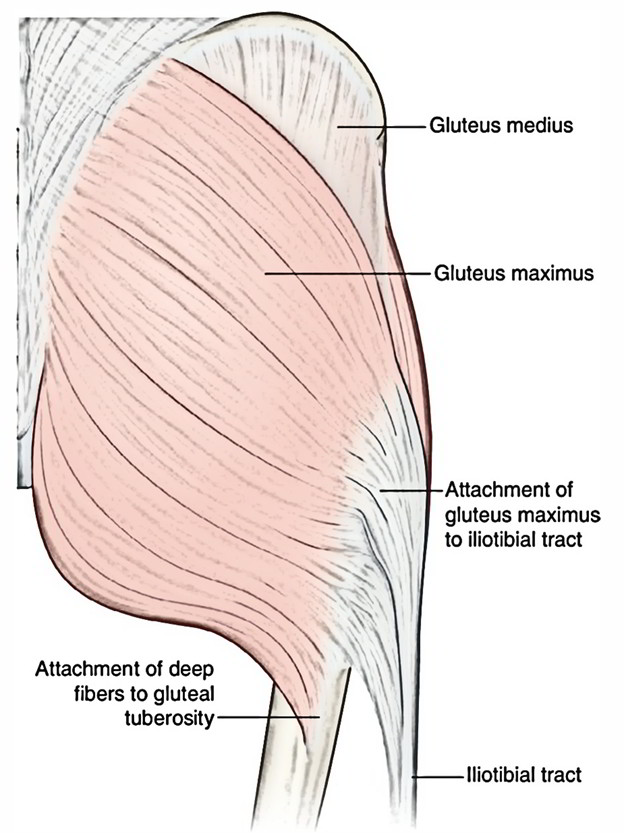The gluteus maximus is quadrilateral in shape and except for the anterosuperior part of the gluteus medius, the common site for intramuscular injections, includes all the other gluteal muscles. It is the largest, most coarsely fibred, and the majority of superficial gluteal muscle.
Bursae
- Trochanteric bursa: Located on the outside of the hip in between the connections of the gluteal muscles and the greater trochanter.
- Gluteus medius bursa: Among the gluteus medius muscle and the greater trochanter, simply medial to the trochanteric bursa it is a shorter bursa.
- Iliopsoas bursa: in between the iliopsoas muscle at the front of the hip joint and the underlying bone.
- Ischial bursa: Among the hamstring tendons and the base of the pelvis.
Origin
It arises from:
- Aponeurosis of erector spinae muscle.
- Dorsal sides of the lower part of sacrum and adjacent part of the coccyx.
- Sacrotuberous ligament.
- Posterior part of the gluteal surface of ilium above and behind the posterior gluteal line.
- Outer sloping side of the dorsal section of iliac crest.
Attachment
It is also attached to:
- Fascia overlying the gluteus medius muscle and, in between the ilium and sacrum.
- Fascia covering the erector spinae muscle.
- Enclosed within two layers of the fascia lata, which covers the thigh and gluteal region.
- Deep distal parts of the muscle attach to the extended gluteal tuberosity of the proximal femur.
Insertion
Laterally, the upper and superficial lower parts of the gluteus maximus, passes over the lateral side of the greater trochanter and descends down the thigh and into the upper leg, and insert into the posterior element of a tendinous thickening of the fascia lata (the iliotibial tract).
The insertion occurs as follows:
- One-fourth of the muscle (deep fibres of the lower part) is inserted into the gluteal tuberosity of femur.
- Three-fourth of the muscle (superficial and deep fibres of the upper part) is placed into the iliotibial tract, which in turn inserts itself on the lateral condyle of the tibia.
Nerve Supply
The gluteus maximus is supplied by the inferior gluteal nerve (L5; S1, S2).
Arterial Supply
Inferior and superior gluteal arteries and – First perforating branch of the profunda femoris artery
Actions
- The chief extensor of the hip joint during standing-up from sitting position and climbing up upstairs is gluteus maximus
- In rising from a sitting position and sustaining the erect posture, It plays a crucial function
- By its connection with the iliotibial band stabilizes the femur on the articular surfaces of the tibia throughout standing and the gluteus maximus is a tensor of the fascia lata, when the extensor muscles are unwinded.
- The upper fibers act as abductors of the hip joints The lower part of the muscle likewise serves as an adductor and external rotator of the limb.
Clinical Significance
Gluteus Maximus Syndrome
A spasm or tightness of this muscle can pull on the coccyx and cause pain when you move into a sitting position or raise yourself. It does not trigger pain while you are sitting. The convulsion, and the pain, is normally just on one side. This syndrome is triggered by a spasm in the muscle of the gluteus maximus. The pain typically disappears when sitting and affects only one side of the body. Diagnosis – The functions that differentiate gluteus maximus pain are:
- It harms while raising or lowering yourself, even into a squatting position.
- The pain doesn’t depend on whether you actually put pressure on the coccyx by sitting- it goes away while you are sitting, instead of getting worse.
- Treatments for these conditions consist of physical therapy or anti-inflammatory pills or injections
Hip Bursitis
- It is inflammation of a bursa or small sack of fluid in between tendon and bone which prevents friction. The bursa can become inflamed causing pain in the hip. Hip bursitis is also referred to as Trochanteric bursitis.
Hip bursitis symptoms:
- Symptoms include pain on the outside of the hip which is worse during activities such as running, climbing stairs or getting out of a vehicle.
- Pain may also radiate down the outside of the thigh. The pain will slowly get worse and the area on the outside of the hip hurts when pressing in.


 (52 votes, average: 4.52 out of 5)
(52 votes, average: 4.52 out of 5)